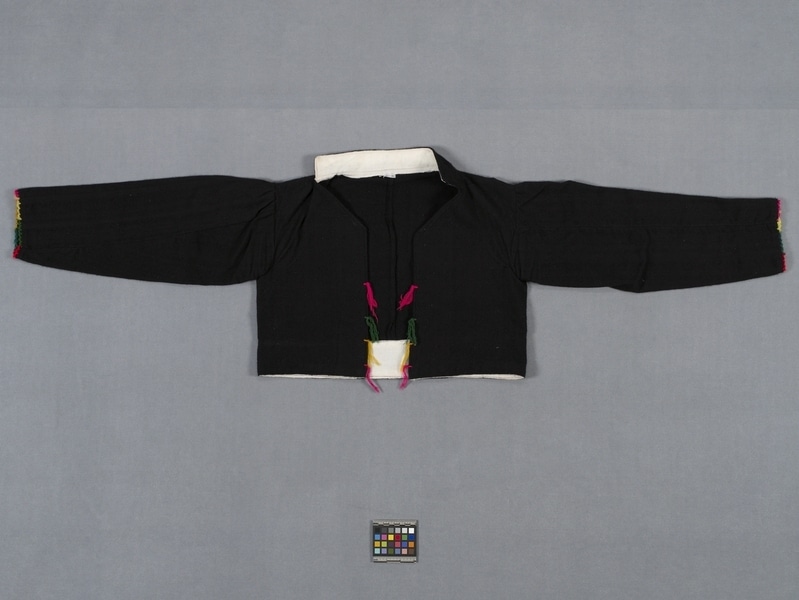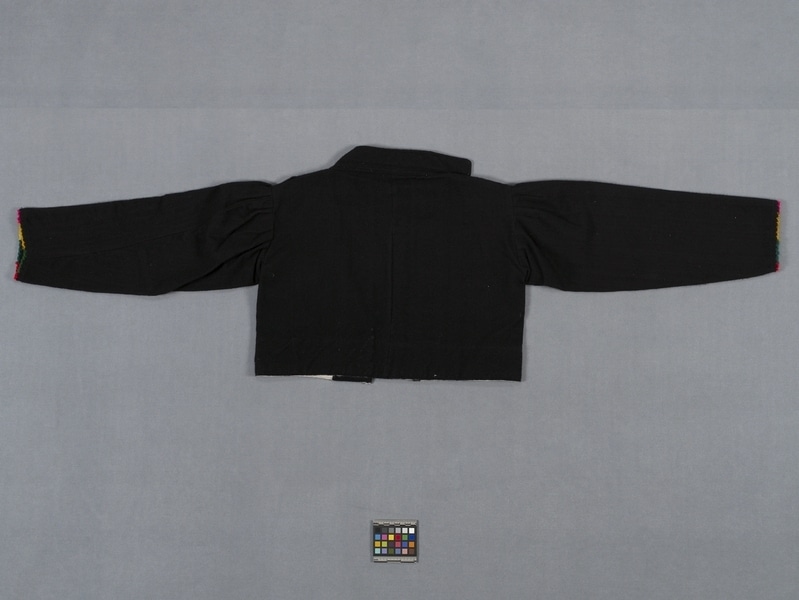Jacket Item Number: Sf385 from the MOA: University of British Columbia


Description
Short black jacket with long sleeves and a half collar. The jacket is decorated with four coloured tassel-like ties in pink, green and yellow arranged on each side of the front opening and the sleeve hems are edged with coloured crochet. The lower jacket edge and collar have white facings.
History Of Use
Bayeta is a type of coarse cloth made on the treadle loom and is used for garments that are cut to size and sewn, such as trousers, shirts and vests. The style, the construction and the loom used are derived from Spanish peasant tradition. Handspun sheep's wool is the traditional material but synthetic yarns are now used as well. The chamarra is worn by men holding community positions when they are engaged in public functions or activities. It is also worn by bridegrooms and padrinos at weddings and by dancers at some fiestas. For most occasions it is worn normally with the arms in the sleeves. Jilakatas or traditional authorities wear their jackets with the yarn closures tied. The yarn tassels are called t'ikacha. A chamarra is sometimes worn across the shoulders, inside out with the white facings showing. The style of wearing the chamarra has changed through time. The grandfather of one Jilakata demonstrated 3 different ways of wearing it that were popular when he was young; across the buttocks with half a twist, across the chest and across the shoulders.
Cultural Context
official garment
Specific Techniques
Commercial synthetic yarns. Z spun and plied 2 s; balanced plain weave cloth, cut and assembled by machine stitching. Sleeve edges are crocheted. Front closures of yarn bunches are stitched through the fabric then knotted.
Narrative
Made and used by Augustin Quispe Mamani for serving as officer of the port in 1982. Subsequently used by 2 of his sons, Domingo and Faustino, for their weddings in July and August 1987. Sold by Augustin's widow, Candelaria Cruz Machaca, in September 1987.
Item History
- Made by Agustin Quispe Mamani (Maker) in Taquile, Puno, Peru between 1981 and 1982
- Collected by Mary Frame during 1987
- Owned by Mary Frame before November 3, 1987
- Received from Mary Frame (Seller) and Museum of Anthropology Shop Volunteers (Funding source) on November 3, 1987
What
- Name
- Jacket
- Identification Number
- Sf385
- Type of Item
- jacket
- Material
- synthetic fibre, cotton fibre ? and dye
- Manufacturing Technique
- woven, cut, sewn, crocheted and knotted
- Overall
- height 47.2 cm, width 146.3 cm
Who
- Culture
- Quechua
- Creator
- Agustin Quispe Mamani (Maker)
- Field Collector
- Mary Frame
- Previous Owner
- Mary Frame
- Received from
- Mary Frame (Seller) and Museum of Anthropology Shop Volunteers (Funding source)
Where
- Holding Institution
- MOA: University of British Columbia
- Made in
- Taquile, Puno, Peru
When
- Creation Date
- between 1981 and 1982
- Collection Date
- during 1987
- Ownership Date
- before November 3, 1987
- Acquisition Date
- on November 3, 1987
Other
- Item Classes
- textiles
- Condition
- good
- Accession Number
- 1274/0013